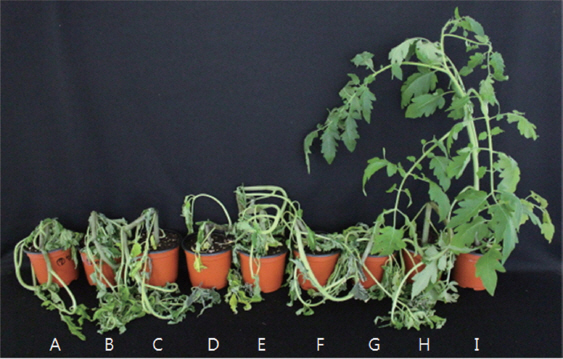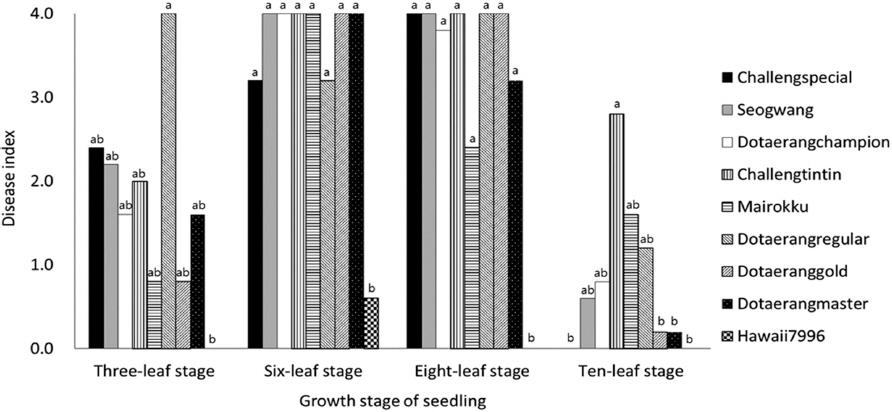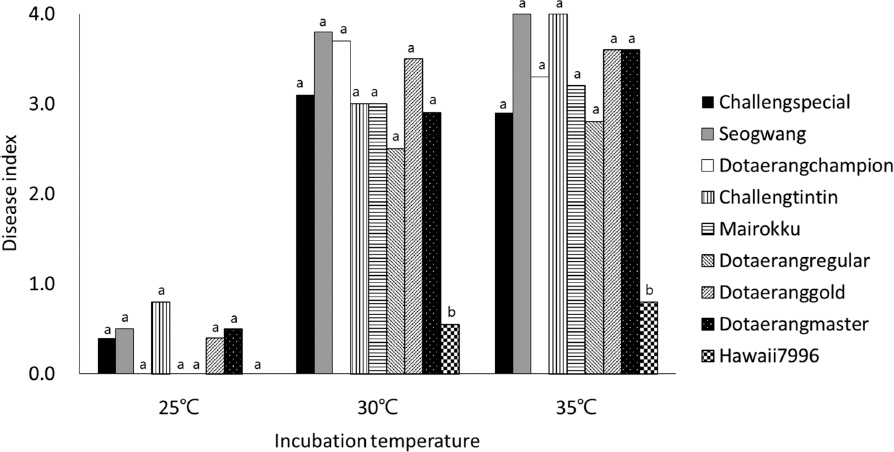Acosta, J. C., Gilbert, J. C. and Quinon, V. L. 1964. Heritability of bacterial wilt resistance in tomato. P. Am. Soc. Hortic. Sci 84: 455-462.
Anand, N., Sadashiva, A. T., Tikoo, S. K., Ramkishun, M. and Reddy, K. 1993. Resistance to bacterial wilt in tomato: gene dosage effects. In: Bacterial Wilt. G. L. Hartman and A. C. Hayward pp 142-148. Hayward ACIAR Proc. 45, Kaoshiung, Taiwan.
The Asian Vegetable Research and Development Center. 1975. Tomato Report for 1975 25-28.
Buddenhagen, I. and Kelman, A. 1964. Biological and physiological aspects of bacterial wilt caused by
Pseudomonas solanacearum.
Annu. Rev. Phytopathol 2: 203-230.

Buddenhagen, I., Sequeira, L. and Kelman, A. 1962. Designation of races in Pseudomonas solanacearum. Phytopathology 52: 726.
Carmeille, A., Caranta, C., Dintinger, J., Prior, P., Luisetti, J. and Besse, P. 2006. Identification of QTLs for
Ralstonia solanacearum race 3-phylotype II resistance in tomato.
Theor. Appl. Genet 113: 110-121.



Danesh, D., Aarons, S., McGill, G. E. and Young, N. D. 1994. Genetic dissection of oligogenic resistance to bacterial wilt in tomato.
Mol. Plant-Microbe Interact 7: 464-471.


Grimault, V., G├®lie, B., Lamattre, M., Prior, P. and Schimidt, J. 1994. Comparative histology of resistant and susceptible tomato cultivars infected by
Pseudomonas solanacearum.
Physiol. Mol. Pathol 44: 105-123.

Han, Y., Min, J., Park, J., Han, K., Kim, D., Lee, J. and Kim, H. 2009. Screening of tomato cultivars resistant to bacterial wilts.
Res. Plant Dis 15: 198-201. (In Korean)

Han, Y.-K., Han, K.-S., Lee, S.-C. and Kim, S. 2011. Control of bacterial wilt of tomato using copper hydroxide. Korean J. Pestic. Sci 15: 298-302. (In Korean)
Hayward, A. C. 1991. Biology and epidemiology of bacterial wilt caused by
Pseudomonas solanacearum.
Annu. Rev. Phytopathol 29: 6587

He, L. Y., Sequeira, L. and Kelman, A. 1983. Characteristics of strains of
Pseudomonas solanacearum from China.
Plant Dis 67: 1357-1361.

Jeong, Y., Kim, J., Kang, Y., Lee, S. and Hwang, I. 2007. Genetic diversity and distribution of Korea isolates of
Ralstonia solanacearum.
Plant Dis 91: 1277-1287.

Kelman, A. and Sequeira, L. 1965. Root to root spread of Pseudomonas solanacearum. Phytopathology 55: 304-309.
Krausz, J. P. and Thurston, H. D. 1975. Breakdown of resistance to Ralstonia solanacearum in tomato. Phytopathology 34: 443-458.
Lee, H. J., Jo, E. J., Kim, N. H., Chae, Y. and Lee, S. W. 2011. Disease responses of tomato pure lines against
Ralstonia solanacearum strains from Korea and susceptibility at high temperature.
Res. Plant Dis 17: 326-333. (In Korean)

Mew, T. W. and Ho, W. C. 1976. Varietal resistance to bacterial wilt in tomato. Plant Dis. Rep 60: 264-268.
Monma, S. and Sakata, Y. 1993. Inheritance of resistance to bacterial wilt in tomato. In: Bacterial Wilt. G. L. Hartman and A. C. Hayward 149: -153. Hayward ACIAR Proc. 45; Kaoshiung, Taiwan:
Nakaho, K. and Takaya, S. 1993. Resistance of tomato rootstock cultivars to Pseudomonas solanacearum evaluated by infection rate under different testing conditions. ed. by Wilt. Bacterial, eds. by G. L. Hartman and A. C. Hayward, pp. 138-141. Hayward ACIAR Proc. 45, Kaoshiung, Taiwan.
Park, E. J., Lee, S. D., Chung, E. J., Lee, M. H., Um, H. Y., Murugaiyan, S., Moon, B. J. and Lee, S.-W. 2007. MicroTom-A model plant system to study bacterial wilt by
Ralstonia solanacearum.
Plant Pathol. J 23: 239-244.

Roberts, P. D., Denny, T. P. and Schell, M. A. 1988. Cloning of the egl gene of
Pseudomonas solanacearum and analysis of its role in phytopathogenicity.
J. Bacteriol 170: 1445-1451.




SAS Institute Inc. 1989. SAS/STAT userŌĆÖguide, version 6. 4th ed SAS Institute Inc, Gary N. C.
Sceelathakumary, L. A. and Peter, K. V. 1984. Inheritance of combined wilt resistance in tomato. Tomato Genet. Coop. Rep 34: 16.
Schaad, N. W., Jones, J. B. and Chun, W. 2001. Laboratory, Guide for Identification of Plant Pathogenic Bacteria. 3rd ed APS Press, St. Paul, USA.
Schmit, J. 1978. Microscopic study of early stages of infection by Pseudomonas solanacearum E. F. S. on ŌĆ£in vitroŌĆØ grown tomato seedlings. Proc. 4th Int. Conf. Plant Pathol. Bacteriol. pp 841-856.
Seo, S. T., Park, J. H., Han, K. S., Cheong, S. R. and Lee, S. 2007. Genetic diversity of Ralstonia solanacearum strain isolated from pepper and tomato plants in Korea. Res. Plant Dis 13: 24-29. (In Korean)
Singh, K. 1961. Inheritance of North Carolina type of bacterial wilt resistance in tomato Lycopersicon esculentum L.M.S. Thesis. University of Hawaii; Honolulu.
Thoquet, P., Olivier, J., Sperisen, C., Rogowsky, P., Laterrot, H. and Grimsley, N. 1996a. Quantitative trait loci determining resistance to bacterial wilt in tomato cultivar Hawaii7996.
Mol. Plant- Microbe Interact 9: 826-836.

Thoquet, P., Olivier, J., Sperisen, C., Rogowsky, P., Prior, P., Anaïs, G., Mangin, B., Bazin, B., Nazer, R. and Grimsley, N. 1996b. Polygenic resistance of tomato plants to bacterial wilt in the French West Indies.
Mol. Plant-Microbe Interact 9: 837-842.

Vasse, J., Frey, P. and Trigalet, A. 1995. Microscopic studies of intercellular infection and protoxylem invasion of tomato roots by
Pseudomonas solanacearum.
Mol. Plant-Microbe Interact 8: 241-251.

Walker, J. M. 1967. Hereditary resistance to disease in Pseudomonas solanacearum. Phytopathology 42: 628-634.
Wang, J.-F., Olivier, J., Thoquet, P., Mangin, B., Sauviac, L. and Grimsley, N. H. 2000. Resistance of tomato line Hawaii7996 to
Ralstonia solanacearum Pss4 in Taiwan is controlled mainly by a major strainspecific locus.
Mol. Plant-Microbe Interact 13: 6-13.


Winstead, N. N. and Kelman, A. 1952. Inoculation techniques for evaluating resistance to Pseudomonas solanacearum. Phytopathology 42: 628-634.








 PDF Links
PDF Links PubReader
PubReader Full text via DOI
Full text via DOI Download Citation
Download Citation Print
Print






